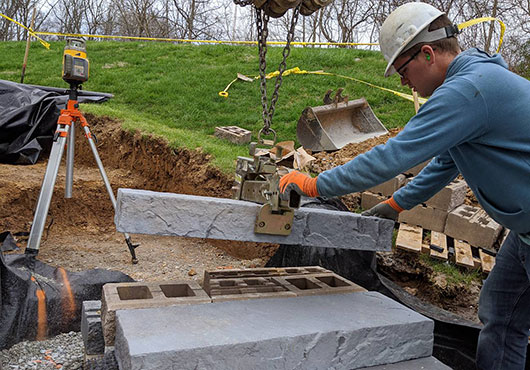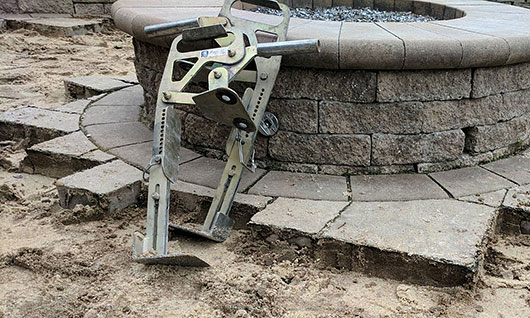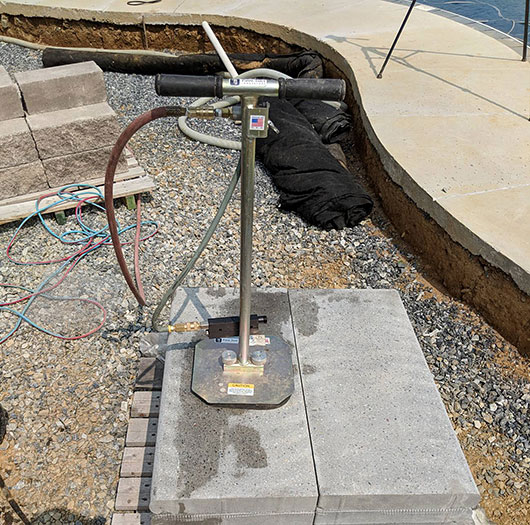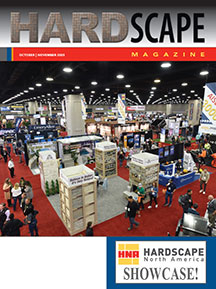Articles written by guest contributors

Block clamps let you boom slabs into place with minimal effort.
My favorite tools & equipment
By Jeremy MartinLike many hardscapers, we started out with basic tools and rented as needed. Our first laser? Single, manual slope. For a grade rod, we used a 2x4 and marked elevations on it. Our screed boards? The straightest 2x4 or 2x6 that we could find in the lumberyard.
As our business grew we invested in tools and equipment that have allowed us to do more with less labor. And that has meant more profit, which is of course is what we want.
Tools and equipment also save our workers. They help our people stay healthy and fit despite working in an industry known for extreme physical labor. I had 2 surgeries on the same knee, both in the same year and before I turned 30. I don’t think my crew needs to go through that.
A prospective employee from another company once told me he preferred landscape over hardscape. That was fine; we needed someone for the landscape crew anyway. But, all of our employees are cross-trained so they can do some hardscape as well as landscape.
I asked him why he preferred landscaping. He said, “I don’t believe my body will take the hardscape work.” So I pried a bit further. I asked how they did their excavation, and his answer was by hand! I told him we hate hand digging, and dislike wheelbarrows too. We believe in using tools and equipment whenever possible to take care of our people.
He joined our crew, and by the end of the first season, he was enjoying hardscaping as much as landscaping!
Don’t we all love equipment?
Rather than hand digging, we use an excavator with 12” and 24” digging buckets, and a 48” grading bucket. I’m blessed with a talented foreman who is one of the best excavator operators I’ve ever had. Put him on that machine, and there’s not much hand digging. The grading bucket works great for both loading spoils onto the truck and for pulling stone off the truck and placing it into areas where the skid steer can’t reach.No doubt equipment increases productivity, but the right equipment increases productivity even more. I struggled for many years with a skid steer that couldn’t lift full cubes of material. The dealer had to place the pallets precisely where I needed them, or I needed to take a few layers off so I could lift them.
I finally replaced our skid steer with a compact track loader powerful enough to move full pallets with ease. I also bought 3 sets of AlturnaMATS ground protection mats. While these were significant investments, they’ve helped us work more days each year. Days when sites would have been too muddy to run equipment are now manageable.

Paver carriers let you carry more pavers in one trip with less bending over and no pinched fingers.
Tools that make a difference
We’ve acquired a number of tools that have made a difference in our company, increasing productivity, helping us do better work and/or saving our backs.- Auto dual slope laser. It takes just a minute or so to program in a slope. Go back to the benchmark, check the elevation for the given task or feature and we’re back at work very quickly.
Here’s an example: Consider excavating a sloped patio, then a level trench for a wall footer, then a deeper sloped trench for utilities, then back to level for building the wall footer, then sloped for patio base. Do you see how many times we switch from level to sloped and back again? With the dual slope, it’s just a matter of a minute or 2 to program the different slope and be on your way again.
There are no string lines needed in the project for elevations. It’s all based on the laser. Before we unload the equipment at the jobsite, we create an elevation plan for each different feature of the project. Everything is based off the benchmark, which is typically a doorsill or other fixed reference point. We use an adjustable grade rod so we can always have our benchmark be “zero” for easy calculations.
There’s never any manually calculating the slope of the base… I can go anywhere on the project within the sight line of the laser and have the slope within 1/10”. In our projects, string lines are reserved for maintaining straight bond lines, never for elevations. - Paver carriers. We can carry more pavers in one trip than we can by carrying a single stack by hand. The paver carrier also saves us the last 15” to 18” of bending over… plus no more pinched fingers! The load is comfortably balanced with one in each hand, versus leaning forward and carrying one large stack with your bare hands.
- Slab handlers. These also prevent pinched fingers and save those last few inches of bending over. Two people can pair up with these to handle large slabs that weigh well over 100 lbs.
- Vacuum lifters. There are various types on the market; ours is hooked up to an air compressor and easily lifts 60+ lb concrete paver slabs. Again, we don’t bend over as far nor do we pinch our fingers. It’s also great for extracting a unit that cracks or needs to be re-cut.
- Block clamps. The trend seems to be towards large, 1- piece slab steps weighing hundreds of pounds. A clamp allows you to boom it into place with an excavator and minimal effort by your crew.
Jeremy Martin co-founded Willow Gates Landscaping in 2005. He became an ICPI instructor in 2016, NCMA in 2018. He also founded Dust Killer Tools to help his company meet 2017 OSHA silica standards. Email Jeremy@DustKiller.tools. Visit WillowGatesLandscaping.com and DustKiller.tools

Vacuum lifters make paver laying faster with less back strain.















